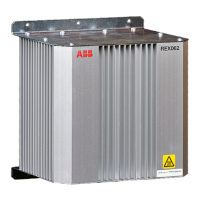0
0 1
2 1 0
m
f
Z
K
Z Z R
= -
× + +
EQUATION1426 V1 EN (Equation 63)
If the denominator in equation 63 is called B and Z0m is simplified to X0m, then the
real and imaginary part of the reach reduction factor for the overreaching zones can be
written as:
( )
( )
( ) ( )
2 2
0 Re
Re 0 1
Re Im
X m B
K
B B
×
= -
+
EQUATION1427 V2 EN (Equation 64)
( )
( )
( ) ( )
2 2
0 Im
Im 0
Re Im
X m B
K
B B
×
=
+
EQUATION1428 V2 EN (Equation 65)
Parallel line is out of service and earthed in both ends
Apply the same measures as in the case with a single set of setting parameters. This
means that an underreaching zone must not overreach the end of a protected circuit for
the single phase-to-earth faults.
Set the values of the corresponding zone (zero-sequence resistance and reactance)
equal to:
R
0E
R
0
1
X
m0
2
R
0
2
X
0
2
+
--------------------------
+
è ø
ç ÷
æ ö
×=
EQUATION561 V1 EN (Equation 66)
X
0E
X
0
1
X
m0
2
R
0
2
X
0
2
+
--------------------------
–
è ø
ç ÷
æ ö
×=
EQUATION562 V1 EN (Equation 67)
8.2.3.6 Setting the reach with respect to load
Set separately the expected fault resistance for phase-to-phase faults RFPPZx and for
the phase-to-earth faults RFPEZx for each zone. For each distance zone, set all
remaining reach setting parameters independently of each other.
The final reach in the resistive direction for phase-to-earth fault loop measurement
automatically follows the values of the line-positive and zero-sequence resistance,
and at the end of the protected zone is equal to equation
68.
Section 8 1MRK 502 071-UEN -
Impedance protection
206 Generator protection REG670 2.2 IEC and Injection equipment REX060, REX061, REX062
Application manual

